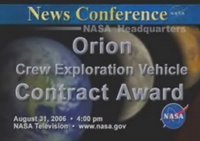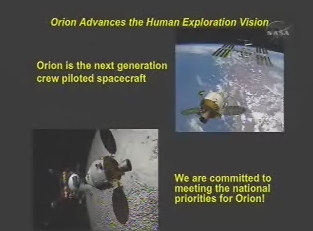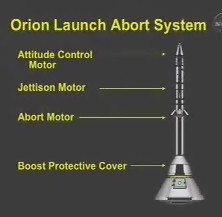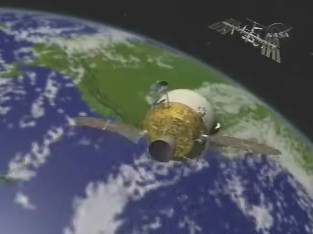Orion Contract Awarded to Lockheed Martin
3:10 CST - 08/31/06
To the Moon and Beyond

After thanking both companies and agreeing that both proposals are viable. ...
The Orion Crew Exploration Vehicle ($3.9 B+) contract goes to...
Lockheed Martin.

Orion Crew Vehicle
"...The Lockheed Martin Orion team -- Lockheed Martin, United Space Alliance, Honeywell, Hamilton Sundstrand, and Orbital -- brings to bear the nation's premier human space flight and exploration expertise in the development of NASA's next generation crew transportation system. Our collective expertise spanning five decades in large-scale systems integration, planetary exploration, human space flight systems and operations, launch vehicles, military aircraft, and autonomous flight systems provides a critical foundation for NASA's vision for space exploration..."






Labels: Constellation, NASA, Science


6 Comments:
This is the same company that failed the last try at a new spaceship wasting almost 1 BILLION dollars. The same company that could not match European and American measurements, causing our Mars probe to crash into Mars.
The GAO has determined that this is a bad deal and well before critical information has been calculated. Good Luck.
This is a primary contract for one phase. Even NG/Boeing will get a sizable share of the entire project (Constellation)
Failure to achieve the (changing)goals doesn't mean all was wasted. The craft didn't exactly fail, although it failed to meet budget restraints. R&D is hard to quantify... We may need craft like these eventually, but the private sector is now being posistioned to step into the near earth orbit flight providers.
The metric problem with the Mars mission was clear scientific proof that even rocket scientists or programmers can be dumbasses occasionally. I knew the metric system was going to be a problem back in the 70s when they told us it would be the "measurement of the future." I wondered then why we would switch to something just because Europe now thought it was best. America does best when it leads.
I'm sure the systems management is now geared to cover that issue and others that would stem from similar issues. The new Orion project draws a lot on what we already know. That means it may not run into overruns like it would if we were starting from scratch on a new system. A newfound clarity of missions and a known system "on steroids" should make the budget more manageable.
I also hope that it was a good decision, and don't want to second guess people that know the two proposals inside and out, and know the budget restraints. They make a lot more "good decisions" than most.
No doubt ther will be overruns, these companies are set up to almost ensure that.
The best qoute I read was, a life threatening occurence; odds with the shuttle is estimated at 1/200, the Orion is designed at a theoretical 1/2000.
I'm a fan of the space program and would like to see it expanded. I worry about these companies and the error rate.
It still amazes me that we have accomplished what we have.
Just wanted to add: If they set the shuttle death accident probabilities at 1/200 - we are WAY over that estimate.
I have a nervous lack of confidence in these big projects, because so much can go wrong and space travel is so unforgiving.
The biggest difference in the "crew safety" would be that Orion will have a launch abort system built in to quickly separate the crew vehicle from the booster rockets at any time. The shuttle, because of its weight, mass, and dependence on the main fuel tank does not have this kind of option. The launch is the one of the most dangerous parts of any mission, so mitigating this one issue alone does a lot for the odds you quoted.
The "error rate" is really really tiny overall, but the fact that errors can be catastrophic in these endeavors makes every one a much bigger situation.
I'll add a slide to show the launch abort system. (If blogspot cooperates today)
The following is from an EPA document filed yesterday. It does a good job of descrbing Orion, what, when, where, how, and why. Or if not?
It's long, but it is an EPA doc after all.
***********************
***********************
National Environmental Policy Act: Development of the Crew Exploration Vehicle
STATUS REPORT
Date Released: Friday, September 1, 2006
Source: NASA History Division http://history.nasa.gov
[Federal Register: September 1, 2006 (Volume 71, Number 170)] [Notices] [Page 52169-52171] From the Federal Register Online via GPO Access [wais.access.gpo.gov] [DOCID:fr01se06-83]
NATIONAL AERONAUTICS AND SPACE ADMINISTRATION
[Notice (06-062)]
National Environmental Policy Act; Development of the Crew Exploration Vehicle
AGENCY: National Aeronautics and Space Administration (NASA).
ACTION: Finding of No Significant Impact.
SUMMARY: Pursuant to the National Environmental Policy Act of 1969, as amended (NEPA) (42 U.S.C. 4321, et seq.), the Council on Environmental Quality Regulations for Implementing the Procedural Provisions of NEPA (40 CFR Parts 1500-1508), and NASA policy and procedures (14 CFR Part 1216 subpart 1216.3), NASA has made a Finding of No Significant Impact (FONSI) with respect to the proposed development of the Crew Exploration Vehicle (CEV). The CEV, a reusable Apollo-like capsule, would enable our Nation's renewed commitment to human space exploration of the Moon and beyond and provide human and cargo access to the International Space Station no later than 2014. Development of the CEV would entail the design, fabrication and assembly of different variants of the spacecraft that meet mission requirements for journeys to Low- Earth Orbit, Moon, Mars, and destinations beyond. Development activities would occur at multiple NASA and commercial facilities throughout the United States. Under the Proposed Action a limited number of CEV spacecraft would be assembled and made available for future testing and flight qualification.
DATES: This Proposed Action may proceed as of the date of signature of this FONSI.
ADDRESSES: The Final Environmental Assessment (EA) that supports this FONSI may be reviewed at the following NASA locations:
(a) NASA Headquarters, Library, Room 1J20, 300 E Street, SW., Washington, DC 20546-0001; and
(b) Jet Propulsion Laboratory, Visitor's Lobby, Building 249, 4800 Oak Grove Drive, Pasadena, CA 91109.
In addition, hard copies of the Final EA may be examined at other NASA Centers (see SUPPLEMENTARY INFORMATION below).
A limited number of hard copies of the Final EA are available for persons wishing a copy by contacting Mario Busacca at the address, electronic mail address, telephone or fax number indicated herein. The Final EA is also available on-line in Acrobat[supreg] format at http://exploration.nasa.gov/documents/cev_finalea.html .
FOR FURTHER INFORMATION CONTACT: Mario Busacca, Lead, Planning and Special Projects, NASA/KSC, Environmental Program Office, Mail Code TA- C3, NASA, Kennedy Space Center, Florida 32899; electronic mail, mario.busacca-1@nasa.gov; telephone, 321-867-8456; and fax, 321-867-8040.
SUPPLEMENTARY INFORMATION: NASA initiated a 30-day public review and comment period for the Draft Environmental Assessment of the Development of the Crew Exploration Vehicle by publishing a notice in the Federal Register on July 20, 2006 (71 FR 41260). The public review period closed on August 25, 2006. NASA received eight comment letters, all from Federal and State agencies and confined to relatively minor factual errors or regulatory requirements in the event that CEV activities were to take place in a specific State. The Final EA has been modified from the Draft EA in response to those comments to the extent applicable. NASA has reviewed the Final EA and has determined that it represents an accurate and adequate analysis of the scope and level of associated environmental impacts. The Final EA is incorporated by reference in this FONSI.
In his January 14, 2004, address to the Nation, President George W. Bush announced a new policy for space exploration with the goal of landing humans on the Moon before the end of the next decade, paving the way for eventual human journeys to other destinations. In pursuing this new policy, NASA has been tasked with developing the spacecraft, launch vehicles and related technologies necessary to travel and explore the Solar System. The CEV represents an important building block in this future exploration architecture.
NASA is proposing to fund the development of the CEV, a new human- rated space vehicle. The CEV would provide human and cargo access to the International Space Station and make possible human return to and exploration of the Moon. Lunar missions would build mission-operations experience necessary for the planning and implementation of human exploration missions to Mars and eventually beyond.
The CEV would consist of a Crew Module, a Service Module and a Launch Escape System. The Crew Module, a conical Apollo-like reusable capsule, would provide habitable volume for up to six crew members, life support, pressurized space for cargo during uncrewed missions, docking with other space vehicles and atmospheric entry and landing capabilities. The Service Module, a cylindrical structure fixed to the rear of the Crew Module, would contain the propulsion and power systems and the thermal control elements for the Crew Module. Electric power would be generated via two deployable solar arrays attached to the Service Module. The CEV Service Module would be similar in design to the Apollo Service Module. The Launch Escape System would be mounted atop the Crew Module and would be similar in design to the Apollo Launch Escape System. The Launch Escape System would be activated if an emergency occurs during launch or ascent operations separating the Crew Module safely from the remainder of the launch vehicle stack.
The CEV design would utilize a modular approach, with different variants keyed to the needs of missions to Low-Earth Orbit, the Moon and Mars. These needs continue to evolve reflecting the results of ongoing trade studies, discussions of mission goals, and analyses of costs, benefits, and risks. The CEV would also be capable of incorporating technological advances that may develop over its service life.
The CEV development activities addressed under the Proposed Action would include design and fabrication of components and subsystems and assembly of a limited number of spacecraft. Development activities would be performed at a number of existing NASA and commercial facilities throughout the United States. If NASA proceeds with CEV development, the Agency would contract with a commercial firm to serve as the prime contractor, with specific design, fabrication and assembly activities to be clarified as the CEV Program matures. These activities would be expected to be consistent with the mission and normal scope of operations of each facility and subject to applicable Federal environmental regulations and those of the respective States and localities.
It is expected that CEV development activities would not involve construction of major new buildings at any NASA or commercial facility. However, additions or modifications to existing facilities or testing areas may be required in the future. As these requirements become known they would be evaluated for compliance with applicable Federal, State and local environmental regulations. Obligations for revised environmental permits and additional environmental documentation would be determined.
All design, fabrication, and assembly of CEV components and subsystems at NASA and commercial facilities would be expected to result in air emissions and waste streams at levels within existing environmental permit limitations at each facility. As such, the short- and long-term environmental impacts would be expected to be within the limits of all applicable environmental laws and regulations. Little or no adverse impact on the local infrastructure (e.g., roadways) or traffic near the facilities involved in CEV development would be anticipated. There should be little incremental impact on employment levels at the facilities involved in CEV development. Thus little or no incremental socioeconomic impacts to regional economies would be expected. CEV development activities at NASA facilities would be considered to be within the normal scope of activities at each facility and therefore would have no disproportionately high or adverse human health or environmental impacts on low-income populations or minority populations.
Alternatives considered but not evaluated further included extending Space Shuttle service and weighing different CEV concepts. Refurbishing the Space Shuttle for long-term cargo delivery and human access to the International Space Station was considered impractical. Major modifications to the Shuttle's design to improve crew safety significantly (e.g., a crew escape system) cannot be implemented easily. Moreover, the Shuttle was not designed to withstand the Earth re-entry speeds of a Lunar mission. If flights were to be extended beyond the planned retirement in 2010, the fleet would require recertification, a costly and lengthy process. Moreover, the President has decided to curtail Shuttle operations after 2010.
Other designs and configurations for the CEV were considered initially by NASA. Winged vehicles, lifting bodies, and slender bodies as well as other approaches were addressed and discarded. In the end, it was determined that the present proposed configuration, a legacy of the Apollo Program, was best suited to the long-term safety and success of the human spaceflight systems needed for exploration of the Moon and Mars. Therefore, none of the other configurations was considered further for the purposes of the Final EA.
The alternative evaluated was the No-Action Alternative (i.e., no CEV development). Failure to develop the CEV would disrupt efforts to achieve long-term goals and objectives set forth in NASA's New Vision for Space Exploration, the centerpiece of our Nation's civilian space policy. The value of the CEV in realizing the scientific, security, and economic interests underlying the Vision is high. While potential environmental impacts would be avoided by cancellation of the proposed CEV development, the loss of scientific knowledge and other national interests could be substantial. The United States would not have a spacecraft capable of transporting humans to the International Space Station once the Space Shuttle is retired or to undertake missions to the Lunar surface, Mars or other destinations in the Solar System. Furthermore, people who currently manage the day-to-day operations of the Space Shuttle would not be able to transfer to the CEV program, and United States would risk losing the only skilled-operations workforce with human space-flight experience.
The Final EA that supports this FONSI may be examined by contacting the pertinent Freedom of Information Office:
(a) NASA, Ames Research Center, Moffett Field, CA 94035 (650-604- 3273);
(b) NASA, Dryden Flight Research Center, Edwards, CA 93523 (661- 276-2704);
(c) NASA, Glenn Research Center, Cleveland, OH 44135 (866-404- 3642);
(d) NASA, Goddard Space Flight Center, Greenbelt, MD 20771 (301- 286-4721);
(e) NASA, Johnson Space Center, Houston, TX 77058 (281-483-8612);
(f) NASA, Kennedy Space Center, Florida 32899 (321-867-2745);
(g) NASA, Langley Research Center, Hampton, VA 23681 (757-864- 2497);
(h) NASA, Marshall Space Flight Center, Huntsville, AL 35812 (256- 544-1837); and
(i) NASA, Stennis Space Center, MS 39529 (228-688-2118). Should NASA proceed with CEV development, the assembled spacecraft would undergo testing and flight qualification prior to obtaining operational status. These actions would be the subject of future environmental documentation.
On the basis of the Final EA, I have determined that the environmental impacts associated with the proposed action would not individually or cumulatively have a significant impact on the quality of the human environment.
Dated: August 29, 2006.
Douglas Cooke, Deputy Associate Administrator for Exploration Systems Mission Directorate.
[FR Doc. E6-14586 Filed 8-31-06; 8:45 am]
BILLING CODE 7510-13-P
*********************
*********************
source:
http://www.spaceref.com/news/viewsr.html?pid=21920
Post a Comment
<< Home